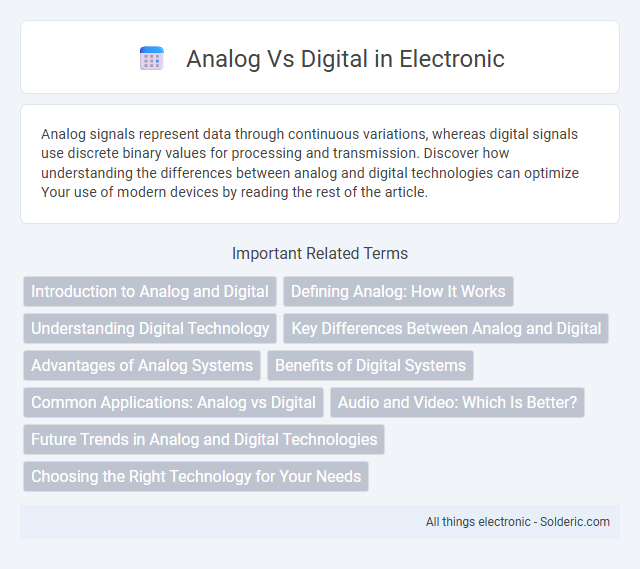Analog signals represent data through continuous variations, whereas digital signals use discrete binary values for processing and transmission. Discover how understanding the differences between analog and digital technologies can optimize Your use of modern devices by reading the rest of the article.
Comparison Table
| Feature | Analog | Digital |
|---|---|---|
| Signal Type | Continuous waveforms | Discrete binary values (0s and 1s) |
| Data Representation | Infinite variations | Finite number of levels |
| Accuracy | Prone to noise and distortion | High accuracy and noise immunity |
| Storage | Analog tapes, vinyl | Hard drives, SSDs, memory chips |
| Transmission | Susceptible to interference | Robust against interference |
| Complexity | Simple circuitry | More complex hardware and software |
| Cost | Lower initial cost | Higher initial cost but cost-effective long-term |
| Examples | Analog clocks, vinyl records, radio waves | Digital clocks, DVDs, computer data |
Introduction to Analog and Digital
Analog signals represent continuous variations of physical quantities and can capture infinite detail within a given range, making them ideal for natural and real-world phenomena such as sound and light. Digital signals encode information as discrete values, typically binary code, enabling more efficient processing, storage, and transmission in modern electronic devices. Understanding the fundamental difference between analog's continuous waveforms and digital's discrete steps is essential for technologies ranging from audio recording to telecommunications.
Defining Analog: How It Works
Analog technology represents continuous signals that vary over time, capturing real-world phenomena such as sound, light, or temperature in a smooth and natural manner. It works by translating physical quantities into corresponding electrical voltages or currents, enabling devices like vinyl records, radios, and analog clocks to process and reproduce signals. The inherent advantage of analog systems lies in their ability to represent infinite variations within a signal, offering high fidelity but also susceptibility to noise and distortion.
Understanding Digital Technology
Digital technology converts information into binary code, allowing for precise processing, storage, and transmission of data compared to analog signals that vary continuously. This discrete representation improves accuracy, reduces noise interference, and enables advanced computing functions vital for modern devices such as smartphones, computers, and digital media. Understanding digital technology empowers you to leverage its benefits for enhanced communication, data management, and innovative applications.
Key Differences Between Analog and Digital
Analog signals represent data through continuous waveforms, capturing variations in amplitude and frequency, while digital signals use discrete binary values, representing data as sequences of 0s and 1s for precise processing. Analog systems often experience noise and signal degradation over distance, whereas digital systems maintain higher fidelity through error correction and signal regeneration techniques. The fundamental difference lies in analog's continuous signal representation versus digital's quantized signal processing, impacting applications in audio, video, and communication technologies.
Advantages of Analog Systems
Analog systems offer superior signal resolution and continuous data representation, which enables more natural and accurate reproduction of sound and images, especially in audio and video applications. Their simplicity and lower cost for basic circuitry make them ideal for devices like analog radios and measurement instruments. Furthermore, analog systems excel in real-time processing with minimal latency, crucial for applications requiring immediate signal response.
Benefits of Digital Systems
Digital systems offer enhanced accuracy and noise resistance compared to analog counterparts, enabling clearer signal processing and improved data integrity. They provide greater flexibility through easy integration with software, allowing for complex data manipulation and efficient storage solutions. Digital technology also supports scalability and faster transmission speeds, making it ideal for modern communication and computing applications.
Common Applications: Analog vs Digital
Analog technology is commonly used in audio recording, traditional radio broadcasting, and analog clocks, offering smooth signal variations that capture natural sound and time changes. Digital technology dominates in computing, digital photography, and streaming services by providing precise, noise-resistant data processing and storage. Your choice between analog and digital applications depends on the need for signal accuracy, flexibility, and data fidelity in the specific use case.
Audio and Video: Which Is Better?
Digital audio and video offer superior clarity, reduced noise, and easier editing compared to analog formats, making them ideal for modern media consumption. Analog signals capture continuous waveforms, providing warmth and depth valued by audiophiles, but they degrade over time and are prone to interference. The choice depends on whether fidelity and convenience (digital) or authentic, nostalgic experience (analog) is prioritized.
Future Trends in Analog and Digital Technologies
Future trends in analog and digital technologies highlight increasing integration of both systems to leverage their unique strengths, such as analog's precision in sensor data and digital's efficiency in processing and storage. Innovations in mixed-signal chips and advancements in AI-driven digital signal processing are driving enhanced performance in telecommunications, healthcare, and consumer electronics. Your ability to adopt these cutting-edge technologies will influence the competitive edge and efficiency of next-generation devices and applications.
Choosing the Right Technology for Your Needs
Choosing the right technology depends on your specific requirements: analog systems offer continuous signals ideal for capturing natural sound and subtle variations, while digital systems provide precise, noise-resistant data perfect for storage and processing. Consider your application's need for accuracy, durability, and compatibility with modern devices to determine whether analog warmth or digital clarity better serves your goals. Evaluating factors like signal quality, cost, and ease of use ensures your choice maximizes efficiency and meets your performance expectations.
Analog vs Digital Infographic

 solderic.com
solderic.com